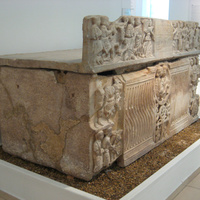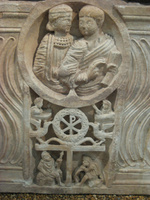Julia Latronilla's sarcophagus
Type:
Sarcophagi
Date:
Probably 330s
Location or Findspot (Modern-Day Country):
Israel
Medium:
Stone
Dimensions:
100 × 208 × 76 cm
Description:
The sarcophagus of a woman named Julia Latronilla depicts her in a clipeus with her husband, who is unnamed. This clipeus is supported by one of the earliest representations of a Christogram, the sign that Constantine supposedly saw before his victory over his rival Maxentius at the Milvian Bridge (312) and a sign of Christian victory over death. The wreathed chi-rho is flanked by doves and by busts of the personified Sun and Moon; below the cross-arms are the Roman soldiers who witnessed Jesus's crucifixion and guarded his tomb.
This unusual sarcophagus combines figural Passion iconography with the S-shaped lines of a strigil sarcophagus (the strigil was a tool for scraping oil from the body in a gymnasium; strigillated sarcophagi were common in ancient Greece and Rome). On the casket proper are scenes of Adam and Eve and three of Jesus's miracles. On the lid are Jesus's entry into Jerusalem, healing miracles, Peter's denial of Jesus, and, at the far right, Abraham's offering of Isaac, a type for the Crucifixion. The inscription on the lid says, in Latin, "Julia Latronilla, a woman most dear to our memory, was buried on August 21 and rests in peace. She lived 46 years, 9 months, 29 days." The year of her death is not given, but on stylistic grounds the sarcophagus is thought to date to the 330s. It is now in the Bible Lands Museum, Jerusalem (BLMJ 1057), but it was probably carved in Rome.
This unusual sarcophagus combines figural Passion iconography with the S-shaped lines of a strigil sarcophagus (the strigil was a tool for scraping oil from the body in a gymnasium; strigillated sarcophagi were common in ancient Greece and Rome). On the casket proper are scenes of Adam and Eve and three of Jesus's miracles. On the lid are Jesus's entry into Jerusalem, healing miracles, Peter's denial of Jesus, and, at the far right, Abraham's offering of Isaac, a type for the Crucifixion. The inscription on the lid says, in Latin, "Julia Latronilla, a woman most dear to our memory, was buried on August 21 and rests in peace. She lived 46 years, 9 months, 29 days." The year of her death is not given, but on stylistic grounds the sarcophagus is thought to date to the 330s. It is now in the Bible Lands Museum, Jerusalem (BLMJ 1057), but it was probably carved in Rome.
Relevant Textbook Chapter(s):
2
Image Credits:
Linda Safran



